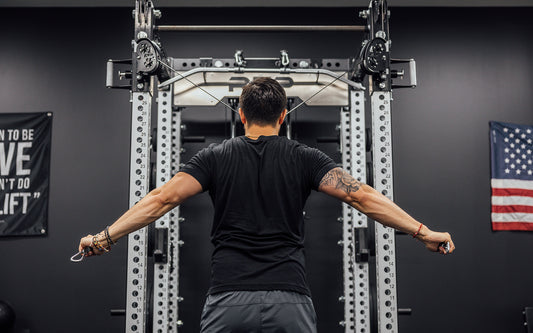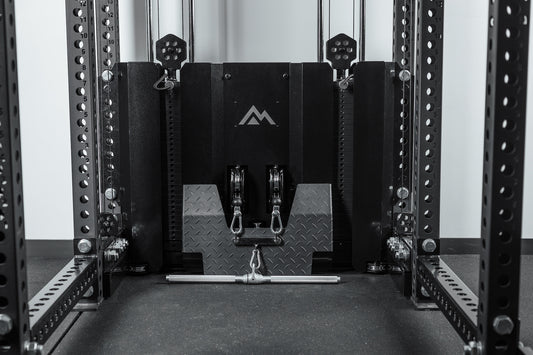
It’s easy to get all giddy-up about a sleek, new power rack and a seggsy barbell. But there’s one part of your home gym that’s easy to overlook, but truly critical to rounding out the build.
Look down. We're talking about your gym floors. Consider them the foundation of your entire gym experience.

Gym flooring protects your joints from impact, your equipment, your floors, and reduces noise. Plus, it creates a comfortable surface for floor exercises.
You’ll find a handful of different options for gym floors; which one you pick depends on your personal needs and preferences.
MATERIALS FOR GYM FLOORING
Some indoor home gyms rely on carpeting or vinyl for the flooring, which could temporarily suffice if you’re on a budget and must use what’s already there. However, carpet and vinyl aren’t shock-absorbent (for your joints or the weight plates) or super durable. Soft carpet can be a safety issue, too, as it lacks stability and support. And carpet can collect sweat, dust, mold, and (worst of all) the ungodly residue of a knocked-over shaker bottle of protein pow-pow. Spill one of those on your carpet and you may as well just put your house up for sale.
OK, so maybe ixnay on the arpetcay.
That’s why many people choose to lay special flooring in their home gyms. Most gym flooring is made from rubber, because it can absorb impact, doesn’t dent or scratch like wood, and is more resilient than foam.

An example is the Rubber Equipment Mat, made from a high-quality rubber that doesn’t absorb moisture, making it resistant to bacteria growth (and whatever nightmarish Demogorgon grows out of spilled shaker bottles). The 3mm (1/8”) Rubber Equipment Mat also works great to keep your equipment from slipping; this mat fits perfectly under the REP Dumbbell Mat and features texture on both sides to keep the mat and equipment solidly in place.
If you want to do heavier lifting, you’ll prefer a thicker 3x4’ Floor Mat that’s ¾" or 19mm thick. (That’s the typical standard thickness for a commercial gym floor.) These have texture on the bottom to keep it from slipping, but no texture on the top so it’s comfortable on your skin when you do floor work. The 4x8’ Floor Mat is also ¾" thick with similar texture – but these suckers are hefty, weighing nearly 100lbs each.
Foam is still shock-absorbent, but heavy or aggressive use can cause gauges in the material over time. It tends to be cheaper, but it’s harder to keep clean, due to the pores, and it won’t last as long as thick rubber. However, if you’re looking for a soft space for bodyweight workouts, yoga, core work, and light weights, foam should do the trick.
An example of a foam mat is REP’s Exercise Mat. It’s lightweight and easy to move around, and it’s made with thick 1.5” (38mm) internal foam. An even thicker foam mat is the 4-Fold Fitness Mat, made from 2.5” (64mm), medium-firmness foam. This mat features four different 2x4’ sections, so you can fold it up and store it even in small spaces. It’s less of a gym floor and more of an added cushion on top for you to practice your handstands and yoga.
TYPES OF GYM FLOORING
You’ll find gym flooring in tiles that can lie side by side, interlocking tiles, rolls, and mats. Rubber mats help spread out the load across a wider area, reducing the point of impact. Rubber Floor Tiles are a cost-effective, rubber flooring option with zero-gap, interlocking edges.

INSTALLING GYM FLOORING
It’s not complicated to lay down your flooring, whether it’s a mat or a tile, although the larger mats can be surprisingly heavy and may require multiple people to move them (see: 4x8’ Floor Mats). The Rubber Floor Tiles are the easiest to install in a basement or small space, because they’re lightweight (8lbs each) and small (about 29x29”). However, they’re thinner (0.3” or about 8mm) than the heavier mats.

If possible, it’s best not to lay rubber flooring on top of soft carpet, as that can create some instability. Ideally, remove the carpet or make your gym on a bare or flatter surface.
Some people recommend putting a layer of paper between hardwood and gym mats to further protect your floors. In addition, you can add a subflooring if you are putting gym mats directly on top of concrete that could have moisture.
If you want to lay a mat on top of vinyl flooring, make sure the material of your floors won’t have a bad reaction with the rubber. Rubber can react with chemicals in some vinyl and create stains.
CARING FOR GYM FLOORING

Just like you wipe down your equipment and clean your barbell (for the love of Thor, please say you clean your barbell!), it’s important to care for your floors. Sweep or vacuum up any loose dust, chalk, or dog hair if you have a gym doggo. Regularly sanitize your mat using a gentle solution that is compatible with your mat’s material. A simple disinfectant wipe from the grocery store provides a quick wipe-down, although better yet are wipes specifically designed for gyms.
In a pinch, you can also use rubbing alcohol or peroxide diluted in water (2:1). But don’t let liquid sit on your mat for a long period of time.
HOW TO PROTECT YOUR FLOORS
- Use bumper plates. These plates are gentler on floors than iron plates.
- Build a deadlift platform to help absorb weight even more.
- Use your power rack whenever possible. Think: rack pulls, barbell rows from the pins.

